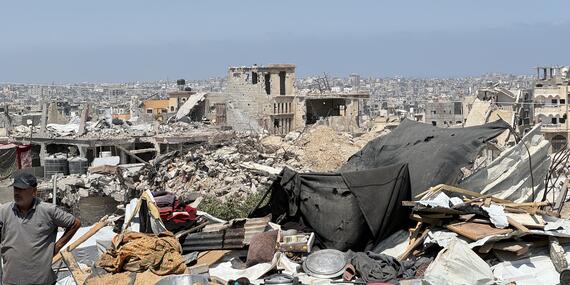Today's top news: Occupied Palestinian Territory, Syria

Occupied Palestinian Territory
OCHA reports that humanitarian partners in Gaza have observed thousands of people fleeing west toward Al Mawasi after the Israeli military issued a new evacuation order earlier today.
The directive affects people located in parts of eastern and central Khan Younis, as well as the Al Salqa area of Deir al Balah. Initial estimates from our partners monitoring population in movements in Gaza indicate that more than 15,500 people had been living in those areas, which comprise more than 30 neighbourhoods.
We call for all parties to the conflict to respect their obligations under international humanitarian law, including by taking constant care to spare civilians and civilian objects. This includes allowing civilians to leave for safer areas and allowing their return as soon as circumstances allow. People must be able to receive humanitarian assistance, whether they move or stay.
Meanwhile, OCHA warns that constraints on water production and sewage pumping in Gaza continue to expose Palestinians to major health risks. Efforts to scale up the water, sanitation and hygiene response are hampered by a lack of generators and alternative energy sources, as well as shortages of spare parts to operate existing generators.
The lack of fuel is another major challenge. Last month, our humanitarian partners working to support water, sanitation and hygiene services in Gaza say they received just over 75,000 litres of fuel. This is a 29 per cent increase compared to June – but still just 70 per cent of the minimum operational threshold.
Meanwhile, the World Food Programme (WFP) warn that ongoing hostilities, damaged roads, and the lack of public order and safety have severely hampered food transport operations in Gaza, forcing WFP to reduce rations. WFP urgently needs fuel deliveries, increased flow of food supplies, and greater capacity to deliver hot meals, particularly in Gaza City and North Gaza.
The agency says they reached some one million people in Gaza in July but stressed that food distribution points continue to face major disruptions due to conflict, evacuation orders, and damage to infrastructure.
WFP warns that it will be unable to bring in the quantity of food required this month unless more border crossing points into Gaza open, and aid workers are able to reach people safely and at scale. The agency was only able to bring in half the quantity of food needed in July.
In the West Bank, WFP estimates that the escalation of violence there could push the number of people facing food insecurity up to at least 600,000. At the start of last year, some 352,000 people in the West Bank were food insecure.
Syria
OCHA is deeply concerned about the impact of escalating hostilities in Syria's Deir-ez-Zor on civilians and the infrastructure they rely on.
At least 20 civilians were reportedly killed and 15 others injured in recent days.
Several civilian facilities were reportedly damaged or affected, including water stations and a UN-supported centre on rural livelihoods.
The fighting has also resulted in power cuts that affected hospitals and water stations.
All crossings along the Euphrates River in Deir-ez-Zor have been closed.
People living in Deir-ez-Zor continue to experience severe water and fuel shortages, very limited access to healthcare facilities and food insecurity.
The UN calls on all parties to the conflict to respect international humanitarian law, including taking constant care to spare civilians and civilian objects in the course of military operations.
The latest escalation comes as Syria is facing its highest levels of need since the start of the crisis, with more than 16 million people requiring assistance this year, as well as critical shortfalls in funding for the response, with this year’s US$4 billion Humanitarian Response Plan only 24 per cent funded at $962 million.
